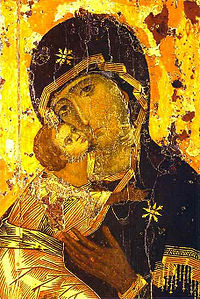Visitation (Christianity)

(Staatliche Museen, Berlin.)
The Visitation is the visit of Mary with Elizabeth as recorded in the Gospel of Luke 1:39-56. It is also the term for a Christian feast day commemorating this visit, celebrated on 31 May in the West (2 July in calendars of the 1263-1969 period, and in the modern regional calendar of Germany), and 30 March in the East.
Contents |
Event
Mary visits her relative Elizabeth, they are both pregnant. Mary is pregnant with Jesus and Elizabeth is pregnant with John the Baptist.
Feasting
Western Christianity
This feast is of medieval origin. It was kept by the Franciscan Order before 1263 when Saint Bonaventure recommended it and the Franciscan chapter adopted it. The Franciscan Breviary spread it to many churches. In 1389 Pope Urban VI, hoping thereby to obtain an end to the Great Western Schism, inserted it in the Roman Calendar, for celebration on 2 July.[1] In the Tridentine Calendar it was a Double. When that Missal of Pope Pius V was replaced by that of Pope Clement VIII in 1604, the Visitation became a Double of the Second Class, and remained so until Pope John XXIII reclassified it as a Second-Class Feast in 1962.[2] It continued to be assigned to 2 July, the day after the end of the octave following the feast of the birth of John the Baptist, who was still in his mother's womb at the time of the Visitation, until in 1969 Pope Paul VI moved it to 31 May, "between the Solemnity of the Annunciation of the Lord (25 March) and that of the Nativity of St. John the Baptist (24 June), so that it would harmonize better with the Gospel story."[3]
Roman Catholics who use a pre-1969 calendar and Anglicans who use the 1662 Book of Common Prayer celebrate the feast on 2 July. So does the entire Catholic Church of Germany, using the post-1969 calendar of Pope Paul VI but with the variations permitted in the German Regional Calendar.
Eastern Christianity
The celebration of a feast day commemorating this event in the Eastern Orthodox Church is of relatively recent origin, dating only to the 19th century. The impetus to establish a feast day in the Liturgical calendar of the Orthodox Church, and the composition of a service to be included in the Menaion were the work of Archimandrite Antonin Kapustin (†1894), head of the Russian Orthodox Ecclesiastical Mission in Jerusalem. The Gorneye Convent in Jerusalem, which was built on the traditional site of the Meeting of the Theotokos (Virgin Mary) and St. Elizabeth, celebrates this Feast on 30 March. (Julian Calendar 30 March corresponds, until 2099, to Gregorian Calendar 12 April.) If 30 March falls between Lazarus Saturday and Pascha (Easter), the Visitation Feast is transferred to Bright Friday. Celebration of the Feast of the Visitation has not yet been accepted by all Orthodox jurisdictions.
See also
- Mariology
References
- ↑ Calendarium Romanum (Libreria Editrice Vaticana 19690, p. 93
- ↑ 2nd Class
- ↑ "Calendarium Romanum" (Libreria Editrice Vaticana, 1969), p. 128
External links
- Catholic Encyclopedia: Visitation of the Blessed Virgin Mary
- The Meeting of the Mother of God and Saint Elizabeth Orthodox icon and synaxarion
|
Life of Jesus: Conception of Jesus |
||
|
The Annunciation |
Events |
Birth of Jesus: The Nativity |
|
|||||||||||||||||||||||||||||
